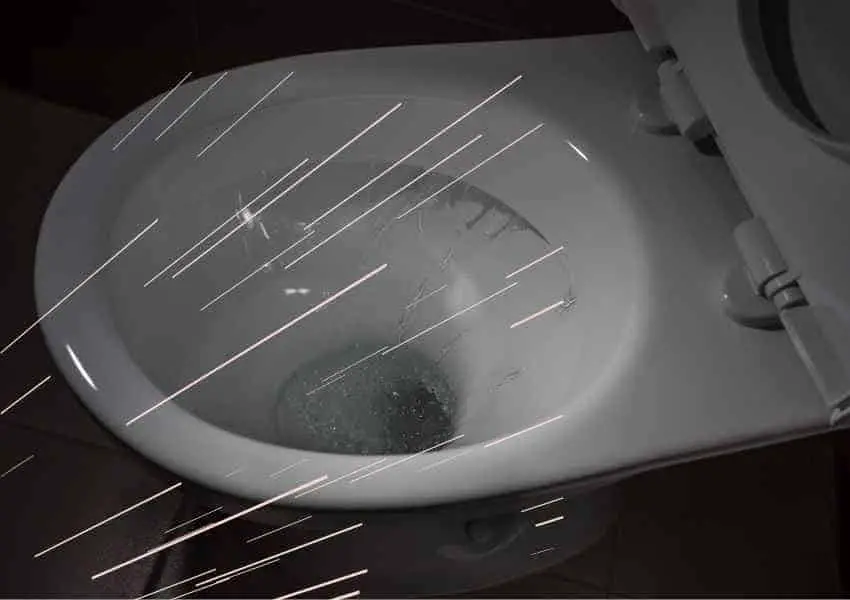Have you ever had a moment where you sit down on the toilet only to suddenly realize that it feels a bit closer to the ground than usual?
And then, in a split second, your heart sinks as you realize that your toilet is, in fact, collapsing through the floor and taking your hard-earned money with it.
If so, don’t worry—you’re not alone. Thousands of Americans have had their toilets collapse through the floor, and even more, have had to deal with the mess and stress of a bathroom floor that’s caving in.
But why does this happen? And more importantly, how can you fix it before it’s too late?

Causes of a Toilet Falling Through the Floor
One of the most common causes of a toilet falling through the floor is the age and condition of the flooring. Over time, flooring can become weak and deteriorate due to water damage, wear and tear, and other factors.
If the toilet is not properly secured to the floor, it can eventually give way and leave a gaping hole in your floor.
And if the toilet was not properly installed according to building codes, it can become loose and separate from the floor, resulting in a toilet falling through the floor.
Signs of a Weak Floor
If you’re concerned that your toilet might fall through the floor, there are some signs to look out for. The first sign of a weak floor is that you can feel it give when you stand on it. If the flooring is particularly soft or spongy, it is probably weak and won’t be able to support the weight of a toilet.
Another sign is if the floor is not level and there are noticeable dips or humps.
This could indicate that the floor is not supported properly and could give way under the weight of the toilet. Finally, if you notice any sagging in the area around the toilet, that can be an indication that the floor is not up to the task of holding the weight of a toilet.
Steps for Solving the Problem
If you’re worried that your toilet may be at risk of falling through the floor, there are three steps you can take to solve the problem.
First, inspect the floor around the toilet to look for signs of structural damage, such as cracks or rot.
Second, if the floor looks damaged, you’ll need to determine what type of floor joist system is being used to support the toilet. Depending on the type of joist system, you may need to add more support beams to the floor to make it stronger. This will make sure that your toilet is securely attached to the floor and won’t fall through.
Tips for Strengthening the Floor
Floor strength is important to ensure that your toilet does not fall through the floor. To strengthen the floor, there are a few steps you can take.
First, check for any weak spots or signs of water damage. If you find any, make sure to repair them.
Second, make sure your subfloor is securely attached to the floor joists. You can do this by adding additional screws or nails.
Third, if you have a plywood subfloor, add a layer of oriented strand board (OSB) to the joists.
Lastly, if you are still concerned about the strength of your floor, consider adding a layer of particle board or fiberboard. These materials will add extra strength and stability to the floor.
Safety Precautions to Take After Repairing the Floor
After fixing the floor, it’s important to take safety measures to keep it from getting broken or hurt again. Here are five safety precautions to take:
- Make sure the floor is level and strong enough, so it doesn’t move or settle anymore.
- Check for signs of water damage or rot, as this could weaken the integrity of the floor.
- Inspect the floor for any loose nails or other sharp objects that could cause injury.
- Place a non-slip mat or rug near the toilet to prevent slipping.
- Periodically check the floor for any changes or weaknesses that could put the toilet or anyone using it at risk.
Conclusion
In conclusion, it is entirely possible for a toilet to fall through the floor, though this is unlikely to happen in a well-maintained home.
To make sure your toilet is safe and secure, you should make sure it is installed correctly and check it often for signs of wear and tear.
Also, it is important to be aware of any plumbing issues or water damage that could weaken the floor beneath the toilet, as this could increase the risk of it falling through the floor. So if you’re dealing with a sagging bathroom floor or a wobbly toilet, don’t wait until it’s too late—take action now!
